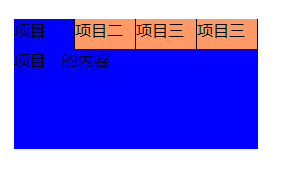To tell the truth, this little trick is expected to be common now. I didn't pay much attention when I started. Until a project was used this afternoon, it reminded me that I developed it according to my own ideas, without referencing others, and felt quite accomplished. Ha-ha.
The idea is simply to set the contents under the li list as absolutely positioned and position them below the li list
Here's an example:
HTML:
<ul>
<li>Item One
<div id="" class="">
<p>Contents of Item 1</p>
</div>
</li>
<li>Item 2
<div id="" class="">
<p>Contents of Item 2</p>
</div>
</li>
<li>Item 3
<div id="" class="">
<p>Contents of Item 1</p>
</div>
</li>
<li>Item 3
<div id="" class="">
<p>Contents of Item 1</p>
</div>
</li>
</ul>CSS:
*{margin:0;padding:0; }
ul{
width:244px;
position:relative; /*Set relative positioning so that child elements are positioned relative to it*/
margin:20px auto;
}
ul li{
list-style:none;
height:30px;
width:60px;
float:left; /*Floating in horizontal row*/
border-right:1px solid #000;
background-color:#ff9966;
}
li div{
display:none; /*Start as hidden*/
width:244px;
height:100px;
position:absolute; /*Absolute positioning*/
left:0;
top:30px; /*Locate below the li list*/
background-color:blue;
}
li:hover{
background-color:blue;
}
li:hover>div{ /*When crossing the li list, the div below this list appears*/
display:block;
}Demonstration:

The second or even third-level menus are all about making the div in the li tag smaller and positioning it relative to the li tag.